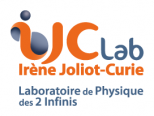
The scientific perimeter of the High-Energy Physics pole consists in the study of the elementary constituents of matter, the quarks (building blocks of protons and neutrons, among other) and leptons (for instance the electron and the neutrino). We know twelve elementary particles currently, organised in 3 families made each of two quarks, one charged lepton and one neutrino. Given their small masses, they are not sensitive to gravitation, so that one ca consider that they are affected only by three interactions:
- the electromagnetic interaction, linked to the electric charge
- the strong interaction responsible for the cohesion of nuclei and nucleons
- the weak interaction causing some radioactive decays and reactions taking place at the heart of stars.
The theory which describes these particles, their interactions and the way that elementary particles become massive throught the Brout-Englert-Higgs, mechanism is called the Standard Model of particle physics. Built at the start of the 1970 and slowly improved, it can explain the results fom many experiments and it predicts many phenomena accuraly. But it leaves many questions unanswered, among which : what is most of the matter observed in the Universe (“dark matter”) made of ? what is the source of the asymmetry between matter and antimatter observed in the Universe ? why are the neutrino masses so small (but not vanishing) ? why are there three families of matter particles ?
The experiments which the researchers from the PHE pole take part in are linked with tests of the Standard Model in order to constrain it better or disprove it.
Three of the 4 main LHC experiments at CERN are present in the PHE pole. In the ALICE experiment, we study the quark-gluon plasma and more generally the strong interaction in th perturbative and non-perturative domains. In ATLAS we probe the Standard Model by measuring accurately many processes, in particular the ones giving information on the properties of the Higg boson, but also looking for signals showing the existence of New Physics. In the LHCb experiment, we work also on observables related to the strong interaction and we look for experimental signals of physics beyond the Standard Model though accurate measurements among hadrons featuring a c or b quark.
In order to study and probe the Standard Model, we are also involved in experiments located outside CERN with: Belle 2 experiment at KEK in Japan, where we study decays of hadrons containing a c or a b quark as well as the tau lepton, and we confront our results with theory predictions. We study in detail the structure of the nucleons at JEFFERSON LAB in the United States, and the effect of nuclear medium on the properties of hadrons at the experiment HADES at GSI in Germany.
We are also involved in the preparation of future experiments within electron-positron colliders by participating in the FCC and ILC projects, which plan to test the Standard Model in detail, and in particular the Higgs boson sector. We are also involved in preparing the future electron-ion collider (EIC) at BNL, which will study the structure of nucleons.
The neutrinos are fundamental particles enabling the lectonics sector of the Standard Model, including possible exploration of physics beyond, as proved by the discovery of the neutrino oscillation phenomenon. Our neutrino group actively address this via several projects, including technological R&D, and experiments (alphabetically ordered): AM-OTech/CLOUD, Double Chooz, DUNE, JUNO, LiquidO, Solid, SuperNemo, and SuperChooz Pathfinder. Moreover, we perform tests on the quantum theory of electromagnetism (QED) in the regime of very strong fields (DeLLight).
These researches and their interpretations are performed in link with the researchers of the Theory pole. In order to build our detectors and to develop future experiments, the physicists of this pole rely on the expertise of the teams of mechanical, electronical, instrumental and computing engineers and technicians of the Engineering pole.






